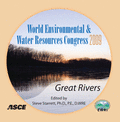Monitoring the Hydrologic Effects of an Extensive Green Roof
Publication: World Environmental and Water Resources Congress 2009: Great Rivers
Abstract
A well known consequence of urbanization is an increase in impervious area (parking lots, streets, roofs, etc), which carries along with it a number of undesirable side effects; such as an increase in storm water runoff and often a degradation of downstream water quality. Storm water best management practices (BMP's) are currently being implemented in many communities across the United States to address these consequences. BMP's increase the pervious area in an urban environment and thus imitate natural storm water processes (i.e. infiltration, filtration, evaporation, etc). BMP's have been shown to reduce runoff quantity whilst improving runoff quality. One specific BMP, green roofs, are proposed to reduce storm water runoff through storage and improve water quality through filtration. While there are data that support these assertions, they are largely insufficient to describe the processes that produce the runoff and water quality changes. As a result, prediction of the hydrologic effects of green roofs (and other BMP's) over a range of conditions often relies on assumed adjustments to empirical parameters such as percent impervious or runoff curve number. In order to provide process-scale data describing hydrologic effects of green roofs, a monitoring system has been installed on an extensive green roof and an adjacent conventional roof on the new Business Instructional Facility on the University of Illinois Urbana-Champaign campus. The green roof being monitored is approximately 280 square meters with 0.20 meters of soil and a variety of sedums planted. The conventional roof is approximately 45 square meters. The green roof station is monitoring: volumetric water content at 15 locations, soil temperature at 9 locations, air temperature and relative humidity at two heights, rainfall, runoff, incoming and reflected solar radiation, and temperature underneath the roof at 5 locations. The conventional roof station is monitoring: roof surface temperature at two locations, air temperature and relative humidity at two heights, rainfall, horizontal wind velocity, runoff, incoming and reflected solar radiation, and temperature underneath the roof at 2 locations. In addition, automated samplers collect water quality samples from the runoff of both the green and conventional roofs and a passive atmospheric sampler monitors deposition of particles. To date atmospheric condition data and soil moisture and temperature data have been collected for 20 storm events.
Get full access to this article
View all available purchase options and get full access to this chapter.
Information & Authors
Information
Published In
Copyright
© 2009 American Society of Civil Engineers.
History
Published online: Apr 26, 2012
ASCE Technical Topics:
- Best Management Practices (BMPs)
- Buildings
- Engineering fundamentals
- Environmental engineering
- Green buildings
- Hydrologic engineering
- Hydrology
- Infrastructure
- Measurement (by type)
- Runoff
- Stormwater management
- Structural engineering
- Structures (by type)
- Temperature effects
- Temperature measurement
- Urban and regional development
- Urban areas
- Water and water resources
- Water quality
- Water treatment
Authors
Metrics & Citations
Metrics
Citations
Download citation
If you have the appropriate software installed, you can download article citation data to the citation manager of your choice. Simply select your manager software from the list below and click Download.
